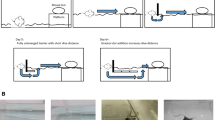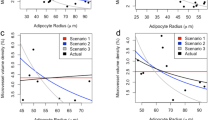Summary
-
1.
Cutaneous and skeletal muscle blood flows cease when alligators are forcibly submerged or when they are disturbed by the investigator. Contrary to previous reports, blood flow to the musculature and tail of freely diving alligators remains normal during submergence, as measured with133Xe (Fig. 2). Cardiovascular adjustments previously reported for diving reptiles appear to be due largely to a psychogenic response (fear) induced by experimental manipulation.
-
2.
Handling and experimental manipulation cause a statistically significant elevation in peripheral blood flow at the beginning of an experiment. Blood flow then gradually decreases and reaches a steady-state after 30 min. Muscles and skin are minimally perfused when at rest. Standard blood flows for muscle ranged from 0.004 to 0.049 ml·g−1 min−1 \((\bar X = 0.018)\) and for skin ranged from 0.006 to 0.039\((\bar X = 0.016)\).
-
3.
Voluntary movement in the absence of disturbance results in a statistically significant increase in blood flow (Figs. 3 and 4). When alligators struggle against a restraint their muscles undergo isometric contraction and blood flow ceases (Fig. 3).
-
4.
Skin blood flow is elevated at temperatures above 30°C during the early portion (<30 min) of experiments (Fig. 4). There are no differences in flows during heating, cooling or steady-state conditions at the same temperature.
-
5.
Muscle blood flow is insensitive to temperature between 25°C and 35°C and increases in response to exercise.
Similar content being viewed by others
References
Alpert J, Garcia del Rio H, Lassen NA (1966) Diagnostic use of radioactive Xenon clearance and a standardized walking test in obliterative arterial disease of the legs. Circulation 34:849–855
Andersen AM, Ladefoged J (1965) Relationship between hematocrit and solubility of133Xe in blood. J Pharm Sci 54:1684–1685
Andersen AM, Ladefoged J (1967) Partition coefficient of133Xe between various tissues and blood in vivo. Scand J Clin Lab Invest 19:72–78
Andersen HT (1961) Physiological adjustments to prolonged diving in the American alligator,Alligator mississippiensis. Acta Physiol Scand 53:23–45
Andersen HT (1966) Physiological adaptations in diving vertebrates. Physiol Rev 46:212–243
Åstrand PO (1976) Textbook of work physiology. McGraw Hill, New York, pp 192–412
Baker LA, Weathers WW, White FN (1972) Temperature induced peripheral blood flow changes in lizards. J Comp Physiol 80:313–323
Belkin DA (1968a) Aquatic respiration and underwater survival of two freshwater turtles. Respir Physiol 4:1–14
Belkin DA (1968b) Bradycardia in response to threat. Am Zool 8:775
Cerretelli P, Blau M, Pendergast D, Eisenhardt C, Rennie DW (1978) Cadmium Telluride133Xe clearance detector for muscle blood flow studies. IEEE Trans Nucl Sci NS-25:620–623
Clausen JP, Lassen NA (1971) Muscle blood flow during exercise in normal man studied by the133Xenon clearance method. Cardiovasc Res 5:245–254
Conn HL Jr (1961) Equilibrium distribution of radioxenon in tissue: Xenon-hemoglobin association curve. J Appl Physiol 16: 1065–1070
Elsner R, Franklin DL, Van Citters RL, Kenny DW (1966) Cardiovascular defense against asphyxia. Science 153:941–949
Gatten RE Jr (1981) Anaerobic metabolism in freely diving painted turtles (Chrysemys picta). J Exp Zool 216:377–385
Gaunt AS, Gans C (1969) Diving bradycardia and withdrawal bradycardia inCaiman crocodylus. Nature 223:207–208
Grigg GC, Alchin J (1976) The role of the cardiovascular system in thermoregulation ofCrocodylus johnstoni. Physiol Zool 49:24–36
Holzman GB, Wagner HN, Ito M, Rabinowitz D, Zierler KL (1964) Measurement of muscle blood flow in the human forearm with radioactive Krypton und Xenon. Circulation 3:27–34
Huggins SE, Hoff HE, Pena RV (1969) Heart and respiratory rates in crocodilian reptiles under conditions of minimal stimulation. Physiol Zool 42:320–333
Jacob JS, McDonald HS (1976) Diving bradycardia in four species of North American aquatic snakes. Comp Biochem Physiol [A] 53:69–72
Johansen K (1964) Regional distribution of circulating blood during submersion asphyxia in the duck. Acta Physiol Scand 62:1–9
Johansen K, Martin AW (1965) Comparative aspects of cardiovascular function in vertebrates. In: Hamilton WE, Dow P (eds) Handbook of physiology, sect 2, vol 3. American Physiological Society, Washington, DC, pp 2583–2614
Jones DR, Bryan RM Jr, West NH, Lord RH, Clark B (1979) Regional distribution of blood flow during diving in the duck (Anas platyrhynchos). Can J Zool 57:995–1002
Jones HB (1950) Respiratory system: nitrogen elimination. In: Glaser O (ed) Medical physics, vol 2. Year Book Publishers, Chicago, pp 855–871
Kanwisher JR, Gabrielsen G, Kanwisher N (1981) Free and forced diving in birds. Science 211:717–719
Lassen NA, Lindbjerg J, Munck O (1964) Measurement of blood flow through skeletal muscle by intra-muscular injection of Xenon 133. Lancet 1:686–689
McIlhenny EA (1935) The alligator's life history. Christopher Publishing House, Boston, p 117
Morgareidge KR, White FN (1969a) Cutaneous vascular changes during heating and cooling in the Galapagos marine iguana. Nature 223:587–591
Morgareidge KR, White FN (1969b) Nature of heat induced cutaneous vascular response inIguana iguana. Physiologist 12:306
Pough FH (1973) Heart rate, breathing and voluntary diving of the elephant trunk snake,Acrochordus javanicus. Comp Biochem Physiol [A] 44:183–189
Robertson SL, Smith EN (1979) Thermal indications of cutaneous blood flow in the American alligator. Comp Biochem Physiol 62:569–572
Smith EN, Allison R, Crowder E (1974) Bradycardia in a free ranging alligator. Copeia 1974:770–772
Smith EN, Robertson SL, Davies DG (1978) Cutaneous blood flow during heating and cooling in the American alligator. Am J Physiol 235:R160-R167
Spotila JR, Soule OH, Gates DM (1972) The biophysical ecology of the alligator: Heat energy budget and climate space. Ecology 53:1094–1102
Wallach JD, Hoessle C, Bennett J (1967) Hypoglycemic shock in captive alligators. J Am Vet Med Assoc 151:894–897
Weathers, WW (1971) Some cardiovascular aspects of temperature regulation in the lizardDipsosaurus dorsalis. Comp Biochem Physiol [A] 40:503–515
Weathers WW, Morgareidge KR (1971) Cutaneous vascular responses to temperature change in the spiny-tailed iguana,Ctenosaura hemilopha. Copeia 1971:548–551
Weathers WW, White FN (1971) Physiological thermoregulation in turles. Am J Physiol 221:704–710
Yeh SY, Peterson RE (1965) Solubility of krypton and xenon in blood, protein solutions, and tissue homogenates. J Appl Physiol 20:1041–1047
Author information
Authors and Affiliations
Rights and permissions
About this article
Cite this article
Weinheimer, C.J., Pendergast, D.R., Spotila, J.R. et al. Peripheral circulation inAlligator mississippiensis effects of diving, fear, movement, investigator activities, and temperature. Journal of Comparative Physiology B 148, 57–63 (1982). https://doi.org/10.1007/BF00688888
Accepted:
Issue Date:
DOI: https://doi.org/10.1007/BF00688888




